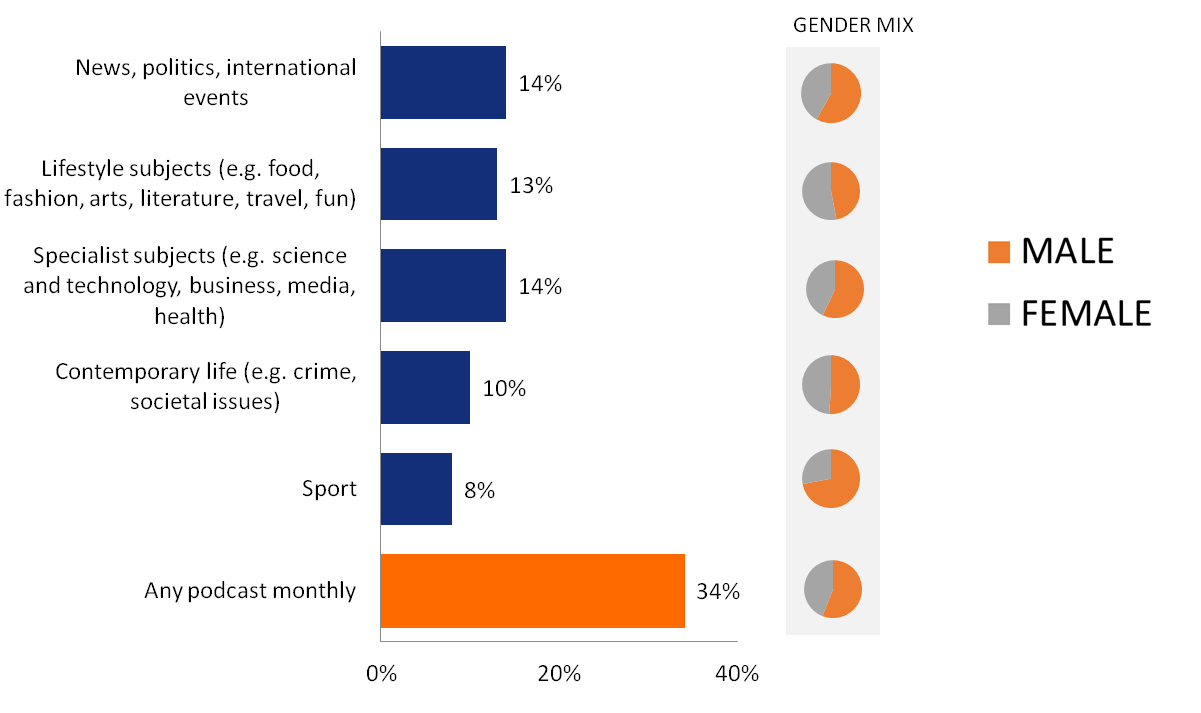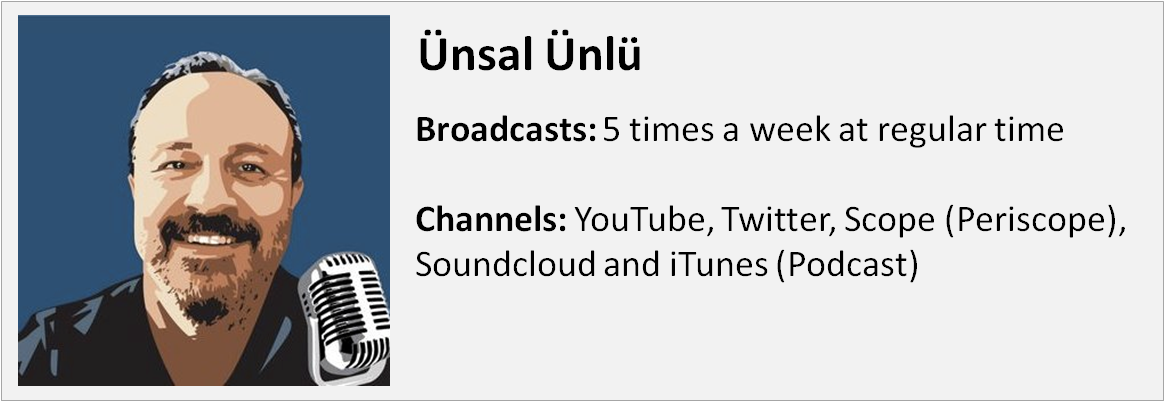Audio is attracting new renewed interest from publishers as mobile listening grows and on-demand technology in the car disrupts linear radio listening. At home, voice-activated speakers like the Amazon Echo and Google Home are creating new opportunities to distribute linear podcasts as well as create new audio products.
In this chapter we explore the popularity of news-related podcasts in 22 countries1 and also look at which demographics are most likely to access these episodic digital audio files, which can be downloaded, subscribed to, or listened to. For the first time this year, we have also asked about the type of podcasts accessed and in a number of countries open-ended responses give us more detail about the most popular programming.
Overall, a third of our sample (34%) listens to a news-related podcast at least monthly but there are significant country differences. In Asian countries like South Korea (58%) and Taiwan (55%), strong smartphone penetration together with high levels of social sharing have helped podcasts grow rapidly. In the United States, which has produced much of the innovation in terms of formats (Serial, S-Town) and business models (sponsorship and targeted advertising), a third (33%) say they have accessed a news podcast in the last month.
Surprisingly, podcasts seem to be least accessed in North European countries with a strong audio tradition such as Finland (24%), Germany (22%), the UK (18%), and the Netherlands (18%). This may be because popular public broadcasters have little incentive to undermine their linear radio listening by producing or promoting podcasts. On the other hand, there may also problems of definition with the term podcast not equally understood across countries. In the UK, for example, much listening comes via the popular BBC iPlayer radio app but on-demand streams and downloads accessed this way are not labelled specifically as podcasts and may not be understood as such in surveys such as ours.
Podcasts are a Significant Opportunity to Reach Younger Audiences
The most striking demographic trend is the extent to which young people have embraced podcasts. The next chart compares the proportion of each age group that uses podcasts at least monthly with those that listen to radio news at least weekly. This is a slightly unfair comparison given that monthly radio listening will be somewhat higher than the chart suggests. Even so, just under half of under 35s are using news-related podcasts, which is almost certainly far more of this group than listen to traditional radio news.
Following the release of iTunes analytics in December 2017, early data suggest that most podcasts are listened to for at least 90% of their duration, giving the lie to the view that young people have minimal attention spans. With advertising spend on podcasts in the United States rising to $220m they could offer a significant commercial opportunity for publishers as well as a route to attracting hard-to-reach millennials.2
Types of Podcasts Consumed
When looking at the types of popular podcasts accessed, we find that news and politics is only one part of the mix. Podcast genres seem to follow a similar mix to a speech radio schedule with lifestyle, food, health, technology, business, and sport playing a significant part. In our open-end responses, comedy programmes were also mentioned but were not captured in our survey question. Podcast listening tends to skew male along with wider news use, with only lifestyle subjects attracting more women.
PROPORTION THAT LISTEN TO EACH TYPE OF PODCAST
Selected markets
Q11F_2018. A podcast is an episodic series of digital audio files, which you can download, subscribe, or listen to. Which of the following types of podcast have you listened to in the last month?
Base: Total sample in selected markets.
Open-ended responses in a number of countries give us a better idea of the type of podcasts consumed.
The US podcast scene is vibrant and varied. Over 500 different podcasts were mentioned, ranging from political talk shows like Ben Shapiro and Rush Limbaugh, adapted public radio shows like This American Life and Freakonomics, and digital-born shows like Pod Save America, a progressive podcast run by four former aides to Barack Obama, Every Little Thing from Gimlet media, and Guys We F**ked, a podcast about sex from comics Krystyna Hutchinson and Corinne Fisher.
In the UK, respondents referenced almost 100 different BBC programmes, Successful US podcasts were also widely consumed while UK newspaper publishers like the Guardian, The Times and the Telegraph feature in the list, with podcasts ranging from politics to sport, and health. New political podcasts consumed include one from Brexiteer and Conservative MP Jacob Rees-Mogg — known as the Moggcast.
In addition to the 22 countries shown above, we also asked about podcasts in Turkey, where we poll using an urban sample. Here we find more than two-thirds of this group using podcasts monthly, partly as a result of improving connectivity and ubiquitous smartphone use amongst the urban population. A number of the most popular podcasts are in English with the BBC’s Global News topping the iTunes chart.
Improving English-language fluency is a key motivation for using podcasts in Turkey, but the platform also provides an alternative platform for free journalism. Many of the top Turkish-language podcasts are critical of the government, with three outlets in particular, Acik Radyo, Ünsal Ünlü, and Medyascope, providing news and debate in this context. One of them is a radio channel, and other two broadcast through Twitter’s Periscope platform. The output is also then reversioned for podcast. Ünsal Ünlü runs one of the most popular podcasts in Turkey, regularly reaching around 45,000 people with broadcasts across all digital platforms. His podcast subscribers alone have more than doubled in the last year.3
Conclusion
Podcasts are both a threat and an opportunity for existing broadcasters. They enable new audiences to be reached beyond national boundaries — and on new devices — but the low barriers to entry have also opened up competition to a vast array of new entrants, including both newspapers and digital-born brands. In many (European) countries they are also challenging the relatively neutral tone of radio broadcasting by injecting both stronger opinions and a greater variety of views. In less free societies they are offering a relatively open platform for democratic debate that is, in theory at least, a bit harder to shut down. Critically, the demographics of podcasting are explosive. The younger generation is embracing content at a time and in a format that works for them — a trend that looks unlikely to be reversed any time soon.
- US, UK, Germany, France, Italy, Spain, Ireland, Norway, Sweden, Finland, Denmark, Belgium, Netherlands, Switzerland, Austria, Japan, South Korea, Taiwan, Hong Kong, Singapore, Australia, Canada. ↩
- https://www.wired.com/story/apple-podcast-analytics-first-month ↩
- Personal conversation with Ünsal Ünlü by Servet Yanatma, Visiting Research Fellow Reuters Institute, Mar. 2018, who also contributed to this section on Turkey. ↩





